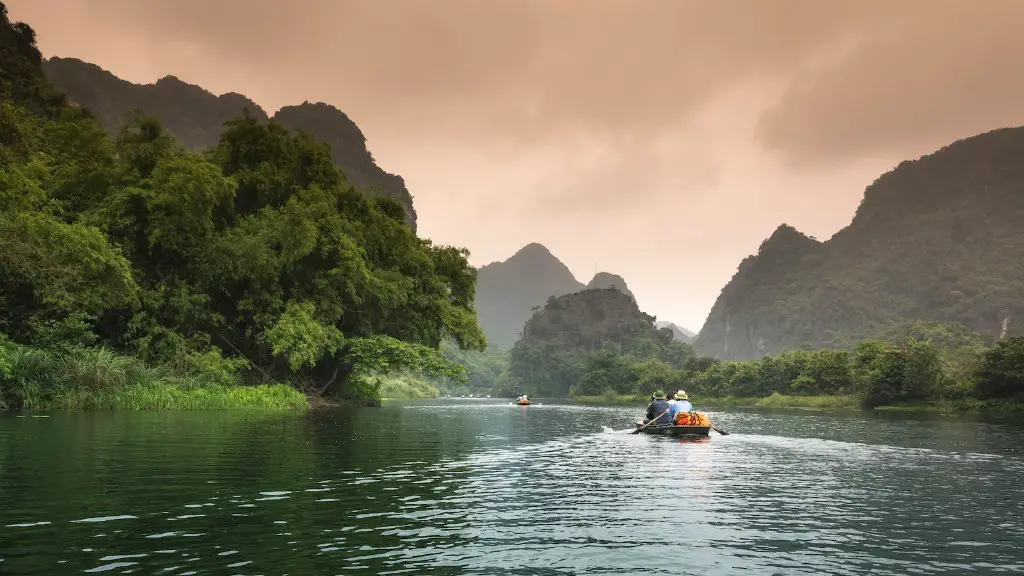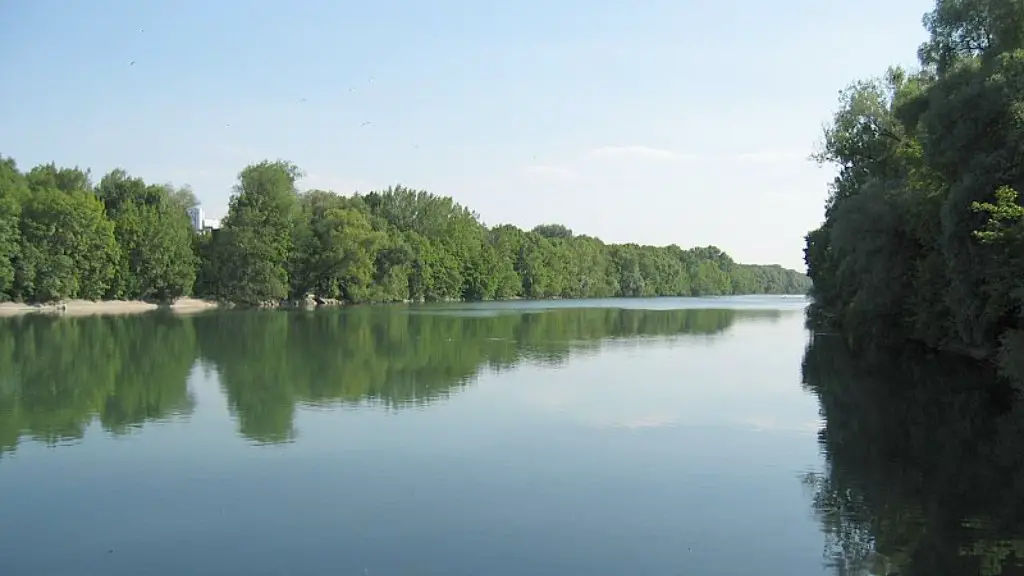Mississippi River:location and key geographical features
The mighty Mississippi River, the fourth longest river in the world, is located in the continental United States of America. It is formed at Lake Itasca in northern Minnesota, and flows southward all the way to the Gulf of Mexico, flowing through Minnesota, Wisconsin, Iowa, Illinois, Missouri, Arkansas, Kentucky, Tennessee, Mississippi, and Louisiana along its great, winding journey.
The river is 2,530 miles long, and is the largest river system in North America, draining an area of over 1,245,000 square miles, or around 41% of the United States. The Mississippi River is known for its unique, winding river channel which carves huge cliffs into the landscape, forming a distinctive border between states. It also has several large tributaries, including the Missouri, Ohio and Arkansas rivers, which add to its size and complexity.
Since its formation, the river has shaped the course of history in the region, playing a major role in developing the culture, economy and geography of the midwest United States. It has been used as the western border and life line of many Native American tribes, and was seen by early settlers as a symbol of promise and hope.
Today, the Mississippi River remains an important source of water, and is responsible for providing industry, recreation and transportation to the region. Many dams and locks have been built on the river, forming a complex network of waterways and transportation corridors, while numerous recreational areas have been formed along its banks, providing a diverse range of activities to enjoy.
In maps, the Mississippi River can be traced from its source in Lake Itasca in Minnesota, which feeds into the Crow Wing River, then takes a winding path through Minnesota, Wisconsin, Iowa, Missouri, Arkansas, Mississippi, and Louisiana before finally meeting the Gulf of Mexico in the south.
Economic & Environmental Impact of the Mississippi River
Today, the Mississippi River continues to play a major role in the economy of the United States. With its powerful currents and unique navigational features, the river allows for large cargo ships to traverse the inland waterways, bringing goods and resources to various regions of the nation. It is also responsible for providing much-needed water to agricultural and industrial sectors.
As well as providing economic opportunities, the Mississippi River also has an important influence on the environment. For many species of plants and animals, the river provides a vital habitat and lifeline. With its complex river systems, aquatic environments and flourishing wetlands, it is home to many species of bird, fish and other wildlife.
Unfortunately, due to the industrial activity that takes place along its banks, the Mississippi River is also subject to a range of environmental problems, such as water pollution, toxic spills, and habitat loss. There has been significant effort made in recent years to address these issues, through clean up efforts, environmental regulations and conservation initiatives.
In recent years, there have been a number of projects undertaken to try and preserve and protect the natural habitats and wildlife of the Mississippi River. These projects have included the reintroduction of native species, the restoration of riverbanks, and the cleanup of neglected wastelands. Ultimately, the aim of these initiatives is to ensure the environmental health of the river, and to protect it for future generations to come.
Recreation & Cultural Significance of the Mississippi River
As well as providing much-needed resources and economic opportunities, the Mississippi River is a source of recreation and enjoyment for millions of people living in and around its waters. From fishing and swimming, to hunting and boating, the Mississippi River offers a wealth of outdoor activities to explore.
The river also provides a unique cultural experience for visitors, with a range of historic sites, monuments, and landmarks that are steeped in both Native American and American history. Many of these sites, such as the Natchez Trace, or the city of Vicksburg, retain their distinctive cultural heritage, and offer visitors a chance to get a glimpse into the past.
Given the historical and cultural importance of the river, it’s not surprising that the Mississippi River has been immortalised in literature and film over the years. Writers such as Mark Twain and Ernest Hemingway have written extensively about the river and its inhabitants, while films such as Huckleberry Finn and The Adventures of Tom Sawyer have become classic representations of life on the Mississippi.
In summary, the Mississippi River is an important part of American culture, and provides a unique blend of natural beauty and cultural history. From its importance in Native American and settler life, to its modern-day role in providing essential resources, recreational activities and cultural experiences, the Mississippi is an integral part of American identity.
Current River Conditions & Dangers
Despite its natural beauty and importance, the Mississippi River remains subject to a range of environmental concerns and dangers. In recent years, flooding along the banks of the river has caused serious damage to communities and businesses, while water pollution and habitat destruction remain major issues. Industrial waste and toxic chemicals have been known to contaminate the waters of the river, endangering both its wildlife and the people that depend on it.
Furthermore, the navigation conditions of the Mississippi River have become increasingly hazardous in recent years, owing to the presence of powerful currents and the deterioration of man-made structures. In some areas, obstacles such as fallen trees, barges and sunken ships have prevented watercraft from navigating the river safely. This can make travel along the Mississippi River a dangerous proposition for any vessel.
Finally, it is important to be aware of other potential dangers that can be encountered when travelling along the river. These include the presence of animals such as alligators and snakes, which can be hazardous to both people and boats, as well as strong winds and storms that can quickly turn a tranquil ride into a dangerous one. For these reasons, it is important to exercise caution when travelling along the Mississippi River, and to be aware of the potential risks and dangers it can present.
Commercial Importance & Shipping
In recent years, the Mississippi River has become increasingly important for the movement of goods and services across the nation. The river’s vast network of locks and dams, combined with its deep channel, provide an ideal environment for the transport of goods and resources along the inland waterways. As a result, many large barges and cargo ships have made their way along the river, moving goods and resources to the various cities and ports of the region.
Moreover, the growth of the container shipping industry has also brought an additional boost to the river’s commercial importance. Every year, thousands of containers arrive from overseas, and make their way along the river to the many warehouses, ports and other locations of the midwest. As such, the Mississippi plays an indispensable role in the global supply chain, connecting the US with the rest of the world.
Ultimately, the Mississippi River’s commercial importance cannot be overstated. Its navigable waters provide an efficient, cost-effective way of transporting goods and services across the US, while its many ports and trading posts offer a variety of opportunities for business and growth.
Impact of Climate Change on the Mississippi River
Climate change is one of the most pressing issues facing the world today, and the Mississippi River is no exception. Over recent decades, the river has experienced an increased occurrence of extreme weather events, such as floods and droughts, which can have a devastating impact on the region.
In addition, the river’s water levels have also been affected by global warming, leading to a reduction in the volume of water flowing down its length. This, in turn, has caused significant damage to the ecosystem of the river, as well as disruption to its navigational conditions.
In order to protect the Mississippi River from further damage, it is essential that action is taken to address climate change. This involves reducing emissions, promoting renewable energy sources, and creating policies and frameworks to protect the environment. Only by doing this can we ensure the health of the river and its wildlife in the future.
As the fourth longest river in the world, the Mississippi River is an iconic waterway with a rich and storied history. Despite the many threats that it now faces, its importance to the nation and its cultural and historical significance remain undeniable. And, with the right protections in place, it can continue to provide pleasure and prosperity to generations to come.





